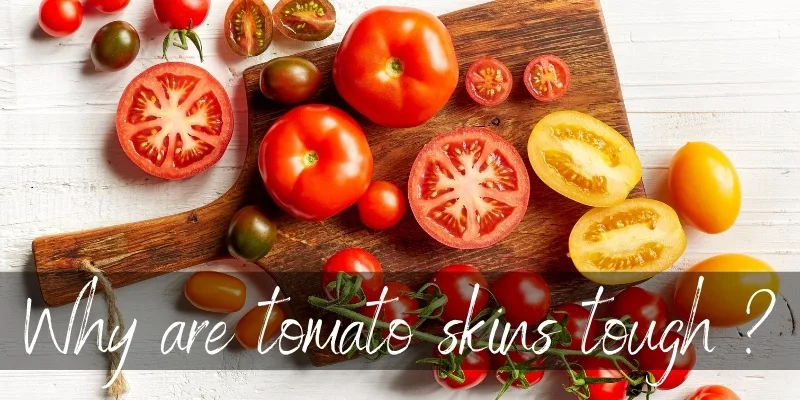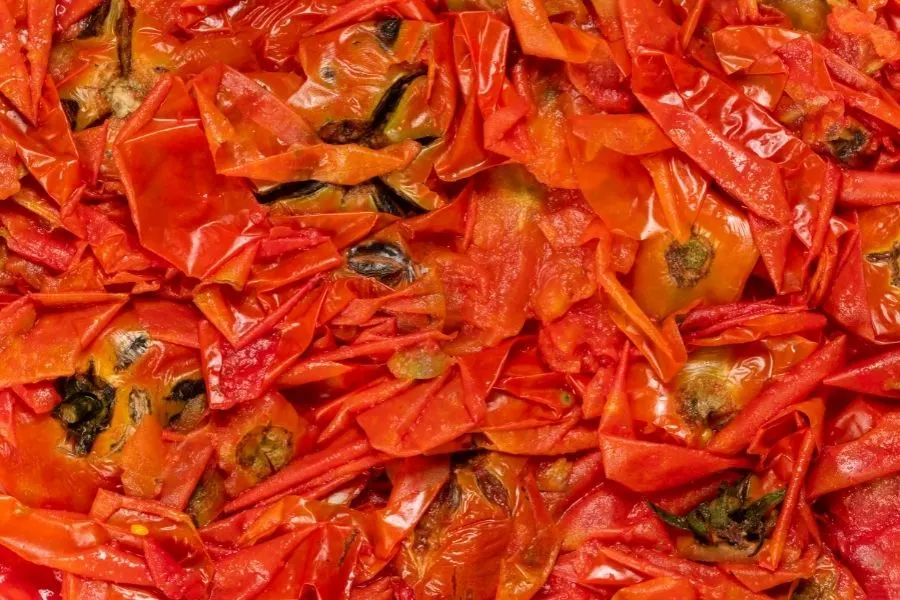As beautiful and flavorful as tomatoes can be, they can also be a real pain when it comes to buying the perfect ones. They’re often too acidic, too tough, and unripe, and they may even have a tough, thick skin. What’s up with that ? And why are so many tomatoes consistently tough-skinned, across the world ?
Well, it seems there are a few ways to explain this, and it’s a combination of natural factors, and human meddling. Let’s take a look.

Why are tomato skins tough ?
Tomato skins end up tough because of two reasons: they were bred this way, or they were subjected to severe environmental factors like excessive and dry heat, insufficient watering, and overexposure to direct sunlight.
All of these factors contribute to a leathery-skinned tomato, mostly due to insufficient water and humidity levels within the tomato itself. Tomatoes are a very sensitive crop.
Environmental conditions really matter
The weather conditions present while your tomatoes grow really change the end result, the fruit itself. Tomatoes need a lot of sunlight, but not high heat, they need mellow heat, and it needs to be consistent. The perfect temperature to ripen tomatoes on the vine is 21-24 C/ 70-75 F.
Too much sun exposure can produce spots that become tough and render the whole fruit’s skin leathery. The fruit still ripens, but the skin acts as a barrier for too much sunlight and heat, a sort of insulation.
Read also: Why Are Tomatoes Acidic ?
Improper watering is also an issue for tomato plants, and can easily lead to split skins or thick skins. Paired with very hot and dry weather, the result is often a tough-skinned tomato.
Some of these conditions can be mitigated by covering the tomatoes to provide some sort of shade, and regular watering habits. Nearly all commercial farms do this, and still tomatoes end up with thick skins. Why ?
Tough tomato skins can be very useful during transport
A tough-skinned tomato is very good for transport. There are tomato varieties – the ones most commonly sold in markets – that have been bred to develop a thicker-than-average skin. This includes plum tomatoes, Roma, beefsteak, and so on. If it’s on the shelf, it’s been transported there from a farm, and it had to survive in one piece.
You see, just like bananas, tomatoes are picked green and tough, packaged and shipped, then ripened with ethylene at the supermarket before being brought out. Don’t worry about ethylene, it’s a gaseous compound released by any and all fruits and vegetables as they ripen and/or start to decompose. Bananas and avocados are ethylene champions.
So in short, the thick skin of those nice plum tomatoes you brought home is very much on purpose. They’re there to keep the tomato whole. If you’re like most people then you’ve never seen a thin skinned tomato, so you don’t know just how fragile these things are.
Try heirloom tomatoes for thin skins
To get a true idea of how soft and easily squashed tomatoes really are, go look for heirloom tomatoes. These are tomatoes that are closer to the tomatoes of late 1800, before the thick skinned versions were developed.
The result is a tender tomato, but you still have to be mindful of weather and watering patterns. The best place to get real heirloom tomatoes is the farmer’s market, or travel the backroads of your state or county. There are plenty of farmers selling their produce right off the farm, and you’ll see signs everywhere.
Are tomato skins easy to digest ?
No, tomato skins are not easy to digest because they have a high amount of fiber that cannot be digested. This is also true for the skins of most bell peppers.
There is no health risk associated with eating tomatoes but not digesting the skins. The skins will easily pass through your digestive system and then exit, through your feces. You may have noticed corn kernels and sometimes seeds (like flax or sesame) come out untouched.

Can you soften tomato skins ?
You cannot soften the skin on tomatoes once they’ve thickened, but you can easily remove them. It’s especially easy with thick skinned tomatoes.
You need a fairly sharp knife and a pot of boiling water, and a bowl of very cold water. Make sure the tomatoes are clean, and then score the bottoms in an X shape. Don’t cut too much into the flesh, you only need to cut into the skin.
Bring a large pot of water to a boil, make sure there is enough room to all your tomatoes, or do this in batches. Once the water is boiling, set heat to low. Gently lower the tomatoes into the water, let boil for about a minute. You should see the skins start to peel back.
Transfer the tomatoes into the bowl of cold water to stop the cooking process. As they cool, the skins will separate from the flesh even more. When they’re cooled enough, you can peel them completely.
Then you may cook them as you wish. If they haven’t gone too soft you can even use them in a salad. But these are not tomatoes that can be put back in the fridge, you need to use them immediately in some way or another.
Another option is to blend the tomatoes, whether it’s an immersion blender or a counter-top one. The only problem with this method is it releases a lot of lycopene (yellow-red pigment) and once you mix in a lot of air, the result is an orange hue instead of red. There is no issue with flavor, only appearance.
In short thick tomato skins are useful from a transport and storage point of view, but they can easily be removed if you want to.

